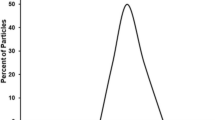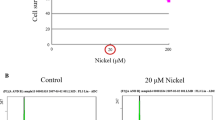Abstract
Some general principles regarding oxidative stress and molecular responses to toxic metals are presented in this manuscript. The remainder of the manuscript, however, will focus on the role of oxidative stress in particulate nickel-induced genetic damage and mutations. The phagocytosis of particulate nickel compounds and the dissolution of the particles inside the cell and the resulting oxidative stress produced in the nucleus is a key component of the nickel carcinogenic mechanism. The crosslinking of amino acids to DNA by nickel that does not involve direct participation of nickel in a ternary complex but nickel-induced oxidative stress will be discussed as well. The selective ability of particulate nickel compounds to silence the expression of genes located near heterochromatin and the effect of vitamin E on the genotoxicity and mutations induced by particulate and soluble nickel compounds will also be discussed. Particulate nickel compounds have been shown to produce more oxidative stress than water-soluble nickel compounds.
In addition to nickel, the role of oxidative stress in chromate-induced genotoxicity will also be discussed with particular attention directed to the effects of vitamin E on mutations and chromosomal aberrations induced by chromate.
Similar content being viewed by others
References
Lin X, Zhuang Z, Costa M: Analysis of residual amino acid-DNA crosslinks induced in intact cells by nickel and chromium compounds. Carcinogenesis 13: 1763–1768, 1992
Klein CB, Frenkel K, Costa M: The role of oxidative processes in metal carcinogenesis. Chem Res Toxicol 4: 592–604, 1991
Costa M, Mollenhauer HH: Carcinogenic activity of particulate nickel compounds is proportional to their cellular uptake. Science 209: 515–517, 1980
Huang X, Frenkel K, Klein CB, Costa M: Nickel induces increased oxidants in intact cultured mammalian cells as detected by dichlorofluorescein fluorescence. Toxicol Appl Pharmacol 120: 29–36, 1993
Huang X, Klein CB, Costa M: Crystalline Ni3S2 specifically enhances the formation of oxidants in the nuclei of CHO cells as detected by dichlorofluorescein. Carcinogenesis 15: 545–548, 1994
IARC: Chromium, nickel and welding. IARC Monographs on the Evaluation of Carcinogenic Risks to Humans, Vol. 49. IARC, Lyon, 1990, p 677
Stohs SJ, Bagchi D, Hassoun E, Bagchi M: Oxidative mechanisms in the toxicity of chromium and cadmium ions. J Environ Pathol Toxicol Oncol 19: 201–213, 2000
Lee YW, Klein CB, Kargacin B, Salnikow K, Kitahara J, Dowjat K, Zhitkovich A, Christie NT, Costa M: Carcinogenic nickel silences gene expression by chromatin condensation and DNA methylation: A new model for epigenetic carcinogens. Mol Cell Biol 15: 2547–2557, 1995
Zhou D, Salnikow K, Costa M: Cap43, a novel gene specifically induced by Ni2+ compounds. Cancer Res 58: 2182–2189, 1998
Salnikow K, Blagosklonny MV, Ryan H, Johnson R, Costa M: Carcinogenic nickel induces genes involved with hypoxic stress. Cancer Res 60: 38–41, 2000
Zhou RH, Kokame K, Tsukamoto Y, Yutani C, Kato H, Miyata T: Characterization of the human NDRG gene family: A newly identified member, NDRG4, is specifically expressed in brain and heart. Genomics 73: 86–97, 2001
Bagchi D, Vuchetich PJ, Bagchi M, Hassoun EA, Tran MX, Tang L, Stohs SJ: Induction of oxidative stress by chronic administration of sodium dichromate [chromium VI] and cadmium chloride [cadmium II] to rats. Free Radic Biol Med 22: 471–478, 1997
Bagchi D, Joshi SS, Bagchi M, Balmoori J, Benner EJ, Kuszynski CA, Stohs SJ: Cadmium-and chromium-induced oxidative stress, DNA damage, and apoptotic cell death in cultured human chronic myelogenous leukemic K562 cells, promyelocytic leukemic HL-60 cells, and normal human peripheral blood mononuclear cells. J Biochem Mol Toxicol 14: 33–41, 2000
Costa M: Toxicity and carcinogenicity of Cr(VI) in animal models and humans. Crit Rev Toxicol 27: 431–442, 1997
Author information
Authors and Affiliations
Rights and permissions
About this article
Cite this article
Costa, M., Salnikow, K., Sutherland, J.E. et al. The role of oxidative stress in nickel and chromate genotoxicity. Mol Cell Biochem 234, 265–275 (2002). https://doi.org/10.1023/A:1015909127833
Issue Date:
DOI: https://doi.org/10.1023/A:1015909127833




